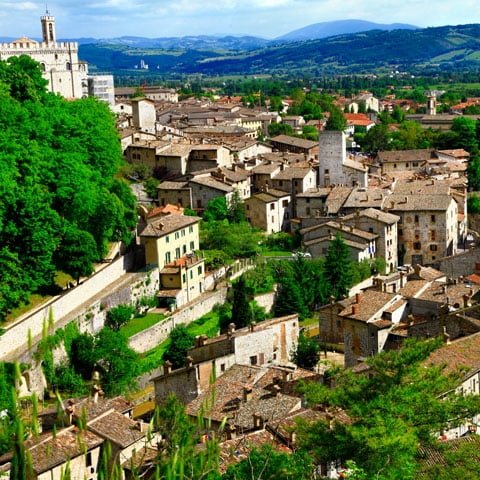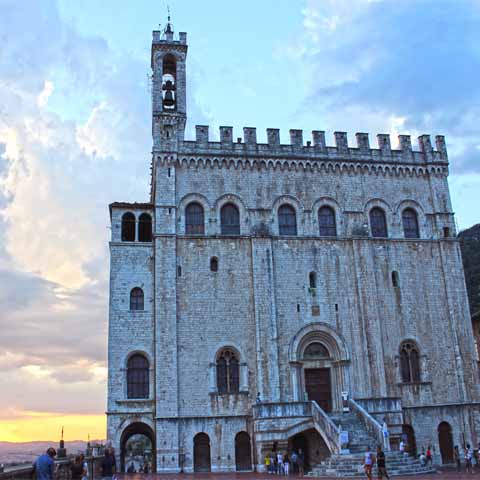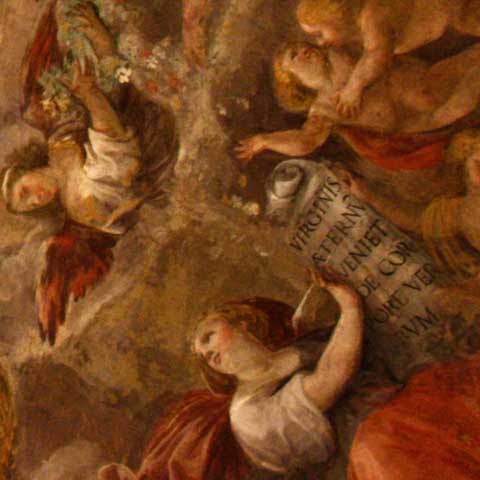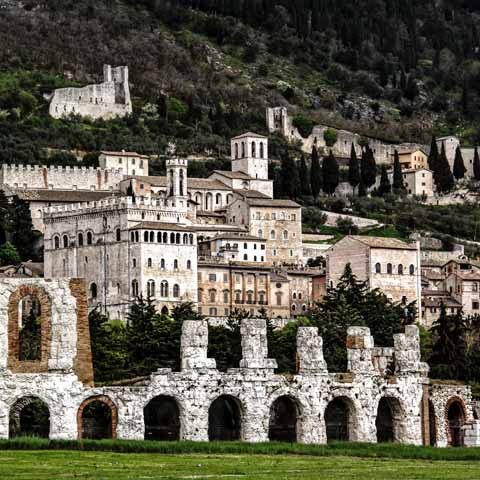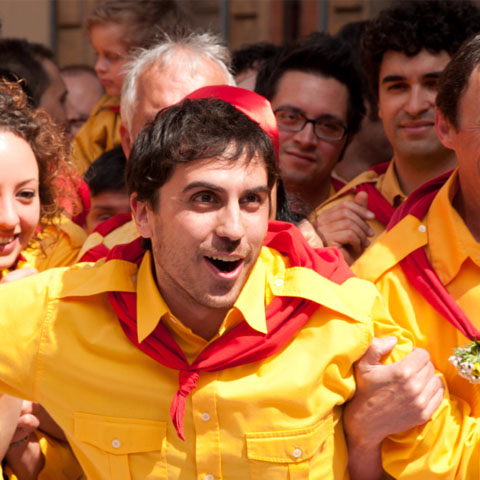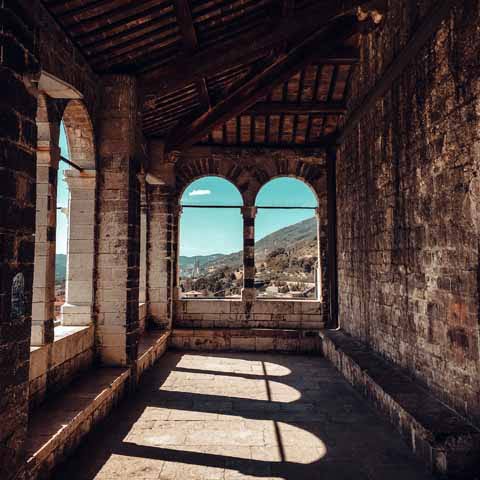Gubbio is a medieval jewel of Umbria which is shaped by its long history. This small town has origins in pre-Roman times. Gubbio is home of the Iguvine Tables, bronze tablets that offer the oldest recorded history of the Umbrian language. Known as the Rosetta Stone of Umbrian languages, they are key to understanding the early days of Gubbio and the surrounding area. Gubbio is also known for being the location where Saint Francis of Assisi tamed a wolf that was terrorizing the locals and was a significant city during Roman times. The city’s glory days were in the fourteenth and fifteenth centuries, as evident by the medieval architecture and historic monuments that fill it.
This rich history can be seen throughout the city’s art, museums, traditions, architecture, and daily life.
ART
At the Palazzo dei Consoli, travelers can explore the Art Gallery and Museum of Archaeology inside the palace. The museums display historic coins, ceramics, and a full gallery of paintings from the Umbrian school.
Inside Gubbio’s Cathedral of saints Mariano and Giacomo, travelers will find some of the city’s greatest pieces of art by local artists of the sixteenth century.
Ceramic-making is an artform in Gubbio. The city is known for its amazing ceramic styles and designs. One way to explore the history of ceramics in the area is to visit the Museo della Maiolica a Lustro, a museum dedicated solely to the lustro style of ceramics. From prehistoric to medieval to Renaissance times, ancient ceramic pieces tell the tale of Gubbio ceramics at this museum.
ARCHITECTURE
With an abundance of stone in shades of grey, small streets, and Gothic-inspired details, the city of Gubbio’s architecture is notably medieval.
One of the city’s most beautiful buildings is the Palazzo dei Consoli. It features an amazing staircase and was constructed in the early 1300s by Angelo da Orvieto.
Many of the homes in the historic district date to the fourteenth and fifteenth centuries when they were the homes of wealthy citizens. Most of them have a unique feature on the façade known as Porta dei Morti, or door of the dead. This small opening next to the main door is very narrow and most are now sealed up by brick. It is said that the openings were used to slide caskets of the dead out of the home, but history says they were likely more used defensively to offer an alternative and easy to guard entrance to the home when an unknown person was at the main door.
The city’s Roman theater stands as a testament to the architecture of the first century. The ruins of this open-air theater show that the structure was made of limestone and that the diameter of the theater seating area was approximately 230 feet, allowing for it to seat nearly 6,000 spectators. There have been traces of mosaic decor found here as well.
The city’s many palazzi all feature incredible architectural details. One example is the Palazzo del Capitano del Popolo, which once served as the residence of the local leader known as the “The Captain of the People” during the Middle Ages. Dating back to the thirteenth century, it is one of many well-preserved medieval buildings found throughout Gubbio’s historic city center.
Another elegant palace is Palazzo Beni, which was created in the fifteenth century after several previous buildings were combined. When visiting the palace today, travelers can admire historic frescoes and other surviving decorations, such as the coat of arms of the Beni family.
The current Bishop’s Palace is more recent and is the result of an eighteenth-century renovation. The building still serves as the seat of the Bishop of Gubbio, and it is also the Gubbio Diocese Archive.
The various important churches throughout the city also offer some impressive architecture. Some of the best are the city’s Cathedral, the Basilica of Sant’Ubaldo, the Church of Santa Maria Nuova, and the church and convent of San Francesco.
The current Gubbio Cathedral dates back to the thirteenth and fourteenth centuries and it replaced a previous Romanesque church on the same site. The simple exterior façade is dominated by a rose window framed by symbols of the Evangelists. The interior of this Gothic church features art by sixteenth century artists as well as fourteenth and fifteenth century frescoes and a Baroque chapel housing frescoes by Francesco Allegrini da Gubbio and paintings by Filippo Gherardi.
Located outside of the city center on the summit of Mount Ingino, the Basilica of Sant’Ubaldo hosts the remains of Gubbio’s patron saint, Saint Ubaldo. The exterior of the church features a simple brick structure with arches, while the interior is characterized by Baroque elements. The church also houses the traditional wooden ceri that are at the center of Gubbio’s famous Festa dei Ceri as well as paintings by Giovanni Maria Baldassini, Felice Damiani, Avanzino Nucco, and Francesco Allegrini.
The Church of Santa Maria Nuova was constructed during the thirteenth century. The Romanesque church houses the revered fresco Madonna of the Belvedere by Ottaviano Nell as well as a fresco by Guido Palmeruccio.
Constructed during the seventeenth century, the Church and Convent of San Francesco is located where the legendary Wolf of Gubbio is said to have lived. The wolf, which would terrorize the citizens of Gubbio, is believed to have been tamed by Saint Francis of Assisi. Inside the church, visitors can admire Madonna and Child with Saints by Giovanni Battista Michelini.
LITERATURE
Gubbio is known for being the home of Bosone Novello Raffaelli, a writer and friend of Dante Alighieri renowned for writing one of Italy’s first novels L’Aventuroso Ciciliano.
The town also makes appearances in various novels, including Hermann Hesse’s Steppenwolf (Gubbio is referenced as a location that the main character once visited), Danièle Sallenave’s Les Portes de Gubbio, and Antal Szerb’s Journey by Moonlight.
CINEMA
Gubbio was used as the filming location for the Italian television series Don Matteo starring Terrence Hill from 2000 to 2011.
A few movies were filmed in Gubbio as well, including Romeo e Giulietta (1968), Fratello sole, sorella luna (1972), and Francesco (1988).
MUSIC
Umbria is a region known for its passion for music. The region features dozens of community bands, music schools, and over one hundred town choirs. Some of Italy’s most famous music festivals are held in Umbria, including the Festival dei Due Mondi and the Umbria Jazz Festival.
In Gubbio, the Gubbio Summer Festival is an internationally known festival that celebrates classical music. The festival features 22 concerts that celebrate Umbrian, Italian, and international music.
Also held in the summer are a variety of musical and theatrical productions held at Gubbio’s Roman theater.
SCIENCE
Gubbio is a well-known city to geologists and paleontologists because it is the location of the discovery of a sedimentary layer. Now known in scientific circles as the “Gubbio Layer,” this layer of sediment is rich in iridium and marks the boundary of the Cretaceous and Paleogene geological periods – about 66 million years ago. Scientists say the layer was formed by debris from a meteor, possibly the meteor that caused the extinction of the dinosaurs. Though the layer was discovered at Gubbio, it can be seen in a variety of places throughout the world.
Travelers can enjoy connecting with the Earth at the Natural Park of Monte Cucco – home to the largest cave in Italy – which is just outside of Gubbio.
Located in the heart of the Umbria region, Gubbio is revered for its impressive number of cultural offerings. From the ancient ruins and medieval architecture to the elegant palaces and art museums, Gubbio is a city meant to be explored at a slower pace.
Don't just see Italy, live it.
Your dream trip to Italy has never been closer
No more endlessly scrolling travel sites. Our travel experts will craft the perfect, one-of-a-kind trip just for you.

300+
DESTINATIONS
We offer more Italian destinations than any travel site. Do and see more with Trips 2 Italy.
1 (of a kind)
ITINERARIES
Because your dream trip to Italy should be designed for you, not for the masses.
100%
PEACE OF MIND
From flights and accommodations, to food and activities - we take care of every detail.
